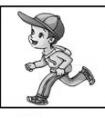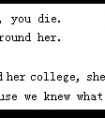last, save, neighbourhood , energy, again, so that ,possible, whether, everyday, do harm toWe all need a healthy environment, but we produce waste every day and -九年级英语
题文
Reduce means “use less”. Don’t waste things. This ___小题3:__money and reduces pollution and waste going into the environment. Before we buy something new, think __小题4:___it is really necessary—or maybe the old one will be just as good! When we do buy things, choose local products if __小题5:____ and try not to buy too many things from abroad. Reuse means “use again”. Use things for as long as possible. When we buy things, make sure that they __小题6:_ a long time. We should look after them__小题7:__ they will last and we should repair them if we can instead of throwing them away and buying new ones. Don’t use a paper cup or a paper bag. It’s better to use a china cup and a lunch box because you can use them __小题8:_. Recycle means “change things into something else”. Although it takes __小题9:__ to change something into something else, it’s better than throwing things away or burning them. Find out what can be recycled in your_小题10:___ and take part in recycling programmes. We should also buy products made from recycled materials, such as recycled paper, to help save trees. |
答案
小题1:does harm to 小题2:everyday 小题3:saves 小题4:whether 小题5:possible 小题6:last 小题7:so that 小题8:again 小题9:anergy 小题10:neighborhood |
试题分析:这是一篇关于环境保护的短文。在短文中作者告诉了我们在我们的日常生活中每天都要产生大量废物。作者针对如何减少这些废物的产生,尽量重复利用每一件物品,提出了适当的建议。 小题1:联系上文but we produce waste every day 可知填does harm to,主语it为单数第三人称,注意谓语动词do后加es。 小题2:根据下文activities 活动,可知句意为甚至最简单的每天的活动……故填everyday。 小题3:根据上文Don’t waste things.可知下文句意为:这会节省钱……主语为单数第三人称,故填saves。 小题4:联系下文or maybe the old one will be just as good!可知填whether,whether or是……还是。 小题5:联系下文try not to buy too many things from abroad 可知句意为如果可能我们选择 本地产品,故填possible。 小题6:联系上文Use things for as long as possible.结合后面时间词a long time 可知填last才,持续,维持。 小题7:联系上下文可知前后是因果关系,故填so that,以便,所以。 小题8:联系上文可知句意为:你能再次使用它们。故填again。 小题9:联系下文to change something into something else,及上文描述可知句意为:把一些动词转变成其他东西虽然需要能量,故填anergy。 小题10:结合上下文可知句意为:在你的街坊四邻找出能重复利用的东西。故填neighborhood。 点评:整个填空题,设空科学合理,考生不难从中领会大意,从而下手会比较顺利,更加注重综合语言能力的运用,需要根据上下文内容,了解词汇用法的同时,结合语境,做出准确的判断。 |
据专家权威分析,试题“last, save, neighbourhood , energy, again, so that ,possible..”主要考查你对 连词成句 等考点的理解。关于这些考点的“档案”如下:
连词成句
考点名称:连词成句
- 连词成句:
即是把错乱排列的词语根据语法或句法特点排列组合成为句式整齐,内容恰当,语气流畅的句子的方法。
他基本的要求是句子完整和流畅没有语法错误,更不要有语病。 连词成句题做题技巧:
首先强调第一个单词的第一个字母要大写,其次句子的最后要有标点符号。然后分句型来做:
1. 陈述句的时候,先找主语,然后找动词,再找其他,记得时间和地点是放在后面的。
2. 疑问句时,有疑问词的情况下找疑问词,然后找助动词,找主语,找其他。没有疑问词的情况下,就找助动词/be动词,再找主语,找其他。
3. 做这一类型的题目时,学生要有一定的基础,会认读单词,熟悉基本句型。
具体可以分一下几步来完成:
一、看清标点符号
1.如果是句号,则是陈述语句。陈述句的基本结构就是主语+谓语+宾语而构成的。
2.如果是问号,则是疑问语句。要先看是特殊疑问句还是由情态动词引导的疑问句。
①如果有where 、what、how等疑问词,那么它就是特殊疑问句,就要把疑问词where 、 what、 how 等放在一句话的最前面,它后面紧接的是be动词也就是我们学习过的am、is、are三个单词。
②如果题目中有can、 may、shall、would等情态动词,那么它就是由情态动词引导的疑问句。
例如:“have I a may new bike (?)” 。这道题目中有一个情态动词may,很显然这就是由情态动词may引导的疑问句。那么我们就要把may放在句子的最前面,后面紧接的就是这句话的主语(主语往往是人或者物)。
很快我们就能写出这句话的前半部分“May I have …”很显然,还剩下的几个单词可以构成一个词组“a new bike”,那么将整句话连起来就是“May I have a new bike ?”(我可以拥有一个新的自行车吗?)。
同样其他的句子,例如:由can 、would、shall等情态动词引导的句子也是这样的方法可以完成。
③如果题目中没有任何的特殊疑问词,也没有任何情态动词,那么它就是我们最最熟悉的一般疑问句了。
例如:“you a are student(?)”。很显然是一个疑问句,而且没有任何特殊疑问词。所以这是一句一般疑问句,一般疑问句的基本准则就是疑问词是be动词(am /is/are),而且要把它们放在句子的最前面。
通过观察我们看到题目中有一个be动词(are),所以这句话就很容易连到“Are you a student ?”(你是一个学生吗?)。
这样的题目还可以先将它当作一般陈述句来做,然后再由陈述句改成一般疑问句。
例如“you a are student(?)”这题还可以先将它写成一般陈述句的形式“You are a student.”。
然后将它写成一般疑问句,即是将这句话的主语和谓语(be动词)对调,得到“Are you a student?”,这样这句话也就完成了。
3.如果是感叹号,则是感叹语句。
①由what引导的感叹句。
我们知道有what引导的感叹句,其基本结构是What + a + adj. + n.。
例如:“What a nice book !”(多漂亮的一本书啊!)
② 由how引导的感叹句。
与what引导的感叹句相似,how引导的感叹句的结构是“How + adj.( +n. /名词短语 + be动词 )!”。二、注意特殊句型
还有一些连词成句的题目看上去似乎是无规律可循。
有这样一个题目:“to time to go it’s school (.)” 这样的题目就要求学生对有些句型的熟练掌握。
这条题目考的是学生对句型“it’s time to do sth.” 的运用和词组“go to school(去上学)”,这是一条交际运用题。
很显然,这条题目的答案应该是:“It’s time to go to shool.”(该到上学的时候了。)
- 最新内容
- 相关内容
- 网友推荐
- 图文推荐
| [家长教育] 孩子为什么会和父母感情疏离? (2019-07-14) |
| [教师分享] 给远方姐姐的一封信 (2018-11-07) |
| [教师分享] 伸缩门 (2018-11-07) |
| [教师分享] 回家乡 (2018-11-07) |
| [教师分享] 是风味也是人间 (2018-11-07) |
| [教师分享] 一句格言的启示 (2018-11-07) |
| [教师分享] 无规矩不成方圆 (2018-11-07) |
| [教师分享] 第十届全国教育名家论坛有感(二) (2018-11-07) |
| [教师分享] 贪玩的小狗 (2018-11-07) |
| [教师分享] 未命名文章 (2018-11-07) |






